Sustainability of Smallholder Livelihoods in the Ecuadorian Highlands: A Comparison of Agroforestry and Conventional Agriculture Systems in the Indigenous Territory of Kayambi People
Abstract
:1. Introduction
2. Materials and Methods
2.1. Study Area
2.2. Sampling and Data Collection
2.3. Data Analysis
3. Results
3.1. Biophysical Characteristics within and between Farming Systems
3.1.1. Agrobiodiversity
3.1.2. Soil Fertility
3.1.3. Microclimate Conditions inside Subsampled Farms
3.2. Main Socioeconomic Characteristics within and between Farming Systems
3.2.1. Livelihoods
3.2.2. Income Levels
3.2.3. Main Agrobiodiversity Uses
3.2.4. Land Tenure and Irrigation Sources
4. Discussion
5. Conclusions
Acknowledgments
Author Contributions
Conflicts of Interest
Appendix A
| Province | Canton | Parish | Total Population | Poverty * (%) | Extreme Poverty * (%) | Illiteracy ≥15 Years (%) | Functional Illiteracy ≥15 Years (%) | Schooling Level (Years) | Indigenous Population (%) |
|---|---|---|---|---|---|---|---|---|---|
| Imbabura | Ibarra | Angochagua | 3263 | 92 | 69 | 29 | 42 | 4 | 92 |
| Otavalo | San Pablo | 9901 | 72 | 39 | 19 | 29 | 7 | 41 | |
| Gonzalez Suarez | 5630 | 84 | 39 | 16 | 26 | 7 | 72 | ||
| Pichincha | Quito | El Quinche | 16056 | 54 | 18 | 6 | 15 | 9 | 6 |
| Cayambe | Cayambe | 50829 | 53 | 21 | 7 | 15 | 9 | 17 | |
| Ascazubi | 5050 | 63 | 21 | 7 | 17 | 8 | 7 | ||
| Cangahua | 16231 | 95 | 64 | 24 | 40 | 5 | 81 | ||
| Olmedo-Pesillo | 6772 | 89 | 57 | 17 | 26 | 6 | 81 | ||
| Otón | 2766 | 93 | 40 | 17 | 32 | 5 | 20 | ||
| Pedro Moncayo | Sata Rosa de Cuzubamba | 4147 | 81 | 28 | 9 | 19 | 7 | 4 | |
| Tabacundo | 16403 | 62 | 23 | 8 | 16 | 8 | 17 | ||
| La Esperanza | 3986 | 71 | 30 | 7 | 17 | 7 | 32 | ||
| Malchinguí | 4624 | 71 | 21 | 13 | 26 | 7 | 2 | ||
| Tocachi | 1985 | 82 | 46 | 12 | 24 | 6 | 5 | ||
| Tupigachi | 6174 | 95 | 46 | 17 | 25 | 6 | 73 | ||
| Napo | Chaco | Oyacachi | 620 | 79 | 23 | 14 | 24 | 7 | 93 |
| Total population ITK | 154437 | - | - | - | - | - | - | ||
| Mean | - | 77 | 36 | 14 | 25 | 7 | 40 | ||
| (Printable Format Sample 1) | ||||
| 1. General Information | ||||
| Survey No: | Date: | |||
| Farmer name: | ||||
| Province: | Canton: | Community: | ||
| Altitude (m.a.s.l): | Coordinates: | Slope (%): | ||
| 2. Main Agroecosystem aspects: | ||||
| Agroecosystem type | Agroforestry | x | ||
| Conventional | ||||
| Main land use | Area (ha) | Age (years): | Remarks | |
| Crops and trees/shrubs | 0.5 | 16 | Slow-forming terraces | |
| Pastures and trees/shrubs | ||||
| Only crops: (monocrops/many crops/rotating crops) | ||||
| Only pastures: (planted pastures, meadows) | ||||
| Others, specify: (grazing communal area, own or communal native forest remnants) | ||||
| Fallow plot in other locality | 1 | 2 | ||
| Total | 1.5 | |||
| 3. Main socioeconomic aspects: | ||||
| Ethnic group | Indigenous | x | Nationality/People: | Kichwa/Kayambi |
| Mestizo | ||||
| Main livelihoods description: | ||||
| Garage (husband and older daughter), agroecological production and commercialisation of fruits, | ||||
| vegetables and minor animals ( whole family), food sale at weekends (younger daughter) | ||||
| Main cash income livelihoods: | ||||
| 1.- Garage | ||||
| 2.- Commercialisation of agroecological products | ||||
| Income categorisation: | ||||
| Low (<375 USD) | Moderate (=375 USD) | High (>375 USD) | ||
| On-farm income | x | |||
| Off-farm income at household level | x | |||
| Irrigation sources | Remarks | |||
| Irrigation system | x | Type | Sprinklers in a communal system | In dry seasons: 3 hours every 2 days per week. |
| Rainfed only | Period/months | |||
| Reservoir | x | Capacity (m3) | 50 | 2 individual reservoirs |
| Other/specify: | ||||
| Land tenure | Remarks | |||
| Formal owner | x | Whole farming land is state recognized | ||
| Informal owner | ||||
| Other/specify: | ||||
| (Printable Format Sample 2) | ||||
| 4. Agrobiodiversity | ||||
| Cultivated biodiversity | ||||
| Forestry component | ||||
| Trees and shrubs (included fruit species): | ||||
| Species | Cultivars/Breeds | Subsistence Use | Commercial Use | Subst./Comerc. % |
| Aguacate/Avocado/Persea americana Mill. | Guatemalteco | x | x | 05/95 |
| Black | x | x | 05/95 | |
| National Black | x | x | 05/95 | |
| National Green | x | x | 05/95 | |
| Jassh | x | x | 05/95 | |
| Crops component | ||||
| Grains and legums: | ||||
| Maíz/Corn/Zea mays L. | Mishka | x | ||
| Morocho | x | |||
| Popcorn | x | |||
| Black | x | |||
| White and soft | x | |||
| Tubers and roots: | ||||
| Potato/Solanum tuberosum L. | Violet | x | ||
| Chola | x | |||
| Super chola | x | |||
| White Chaucha | x | |||
| Unique | x | |||
| Curipampa | x | |||
| Fruits (other fruits different from trees and shrubs: | ||||
| Taxo/banana passionfruit/Passiflora sp. | x | x | 95/05 | |
| Uvilla/Golden berry Physalis peruviana L. | x | |||
| Vegeables: | ||||
| Col/Cabbage/Brassica oleracea L. | Head cabbage | x | x | 10/90 |
| Leaf cabbage | x | x | ||
| Loose leaf cabbage | x | x | ||
| Hearth cabbage | x | x | ||
| Purple cabbage | x | x | ||
| Pastures (included wild species in meadows): | ||||
| Vicia sp. | x | |||
| Alfalfa /Lucerne/Medicago staiva L. | x | |||
| Avena/Barley/Hordeum vulgare L. | x | |||
| Medicinal, aromatic and condiment species (planted): | ||||
| Romero/Rosemary/Rosmarinus officinalis L. | x | |||
| Yuyungilla | x | |||
| Yerba Buena/Spearmint/Mentha spicata L. | x | |||
| Matico/Aristeguietia glutinosa (Lam.) R.M.King & H. Rob. | x | |||
| (Printable Format Sample 3) | ||||
| 4. Agrobiodiversity (continuation) | ||||
| Animal component | ||||
| Livestock: | ||||
| Species | Cultivars/Breeds | Subsistence Use | Commercial Use | Subst./Comerc. % |
| Vacas/Cattle | ||||
| Ovejas/Sheep | ||||
| Chivos/Goats | ||||
| Llamas | ||||
| Minor animals: | ||||
| Gallinas/Chickens | x | x | 10/90 | |
| Cuy/Cavy/Guinea pigs | x | x | 10/90 | |
| Chanchos/Pigs | x | x | 5/95 | |
| Conejos/Rabbits | x | |||
| Palomas/Doves | x | |||
| Other species/varieties component (ornamental, cultural, burden species, etc.) | ||||
| Achera/Canna indica L. | Red | x | ||
| Cartucho/Zantedeschia aethiopica (L.) Spreng. | White | x | ||
| Green | x | |||
| Geranio/Geranium sp. | Fuchsia | x | ||
| Associated biodiversity | ||||
| Wild plants: | ||||
| Paico /Dysphania ambrosioides (L.) Mosyakin & Clemants | x | |||
| Llantén/Grater plantain/Plantago major L. | x | |||
| Verbena/Vervena sp. | x | |||
| Wild animals: | ||||
| Birds | ||||
| Chihuako/Mirlo/Turdus sp. | x | |||
| Guiragchuru/Pheucticus chrysogaster | x | |||
| Reptiles | ||||
| Lagartija negra/Black lizard | x | |||
| Culebra verde/Green snake | x | |||
| Amphibians | ||||
| Rana marsupial-Verde/Andean marsupial tree frog/Gastroteca riobambae | x | |||
| Mammals | ||||
| Raposa/Common opossum/Didelphys marsupialis | x | |||
| Chucuri/Long tail weasel/Mustela frenata | x | |||
| Invertebrates | ||||
| Saltamontes verde/Green grasshopper | x | |||
| Catso negro/Black soil beetle-scarab | x | |||
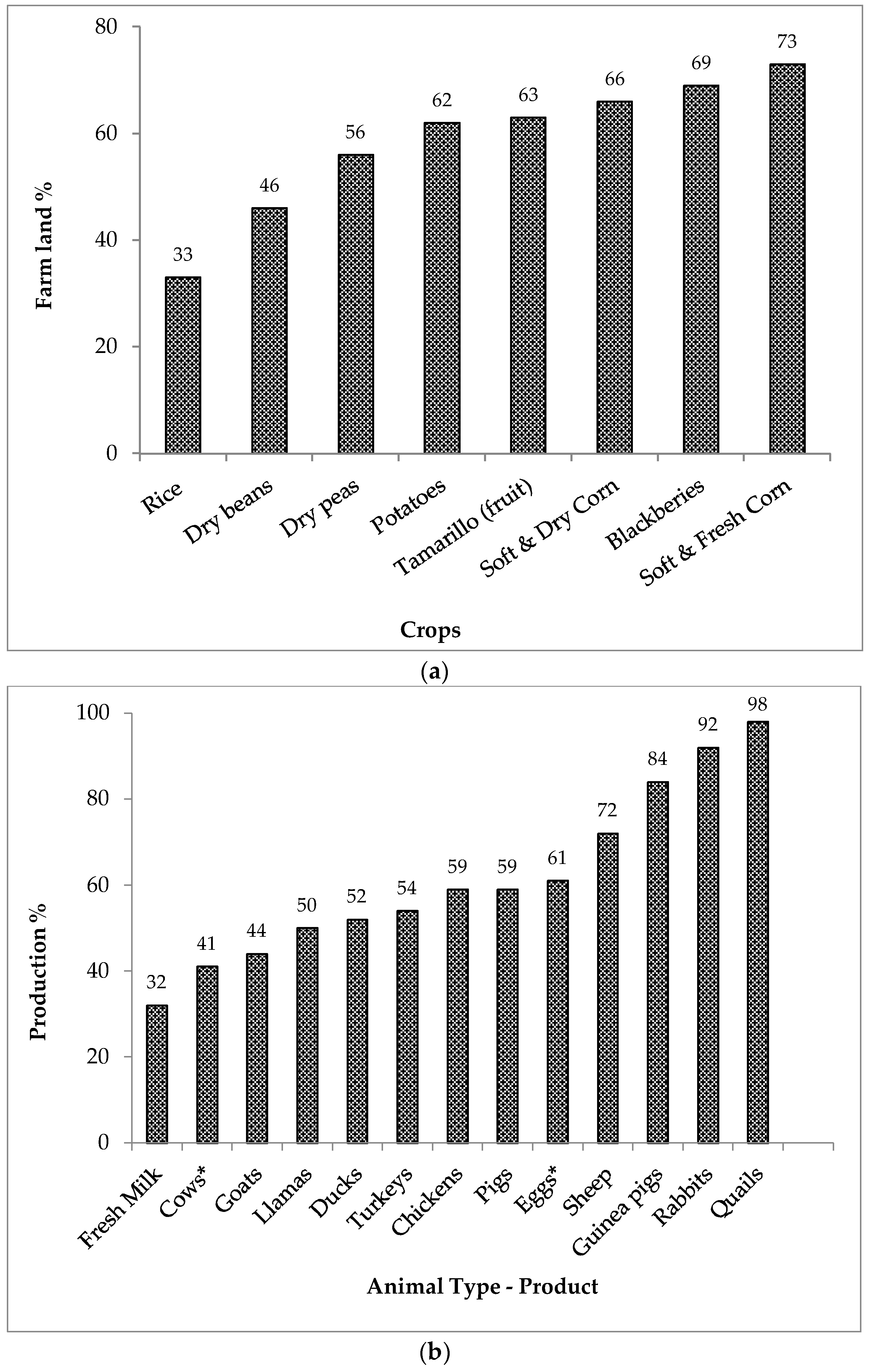
Appendix B
| Soil Samples | Soil Parameters © | ||||||||||||||||||
|---|---|---|---|---|---|---|---|---|---|---|---|---|---|---|---|---|---|---|---|
| pH | CE * | SOM ** | N | P | K | CEC *** | Texture | BD ¤ | FC º | MY † | MAB ‡ | ||||||||
| dS/cm | % | % | ppm | meq/100 g | meq/100 g | Class | (g/cc) | (%) | (CFU/g) | (CFU/g) | |||||||||
| Agroforestry Systems | |||||||||||||||||||
| 1 | 6.2 | L | 0.3 | L | 5.4 | O | 0.3 | O | 39.2 | O | 1.2 | O | 18.4 | O | Sandy loam | 1.2 | 35.6 | 127,000 | 1,273,000 |
| 2 | 7.2 | H | 0.3 | L | 4.1 | O | 0.2 | O | 44.5 | O | 1.2 | O | 19.6 | O | Sandy loam | 1.4 | 47.9 | 54,000 | 1,640,000 |
| 3 | 6.3 | L | 0.3 | L | 4.8 | O | 0.2 | O | 48.8 | O | 0.7 | O | 16.6 | O | Sandy loam | 1.3 | 23.6 | 104,000 | 818,000 |
| 4 | 7.1 | H | 0.3 | L | 3.6 | O | 0.2 | O | 57.3 | O | 1.2 | O | 18.4 | O | Sandy loam | 1.4 | 34.8 | 27,000 | 1,820,000 |
| 5 | 7.7 | H | 0.7 | O | 4.2 | O | 0.2 | O | 40.6 | O | 2.8 | H | 20.9 | O | Sandy loam | 1.3 | 40.0 | 54,000 | 5,364,000 |
| 6 | 6.5 | O | 0.1 | L | 3.2 | O | 0.2 | O | 31.9 | O | 0.7 | O | 19.2 | O | Sandy loam | 1.6 | 10.0 | 86,000 | 5,864,000 |
| 7 | 6.2 | L | 0.1 | L | 3.5 | O | 0.2 | O | 29.3 | O | 0.3 | O | 16.4 | O | Sandy loam | 1.3 | 16.1 | 180,000 | 3,864,000 |
| 8 | 6.1 | L | 0.2 | L | 3.4 | O | 0.2 | O | 33.6 | O | 0.6 | O | 19.7 | O | Sandy loam | 1.4 | 20.3 | 209,000 | 5,818,000 |
| Mean | 6.6 | O | 0.3 | L | 4.0 | O | 0.2 | O | 40.6 | O | 1.1 | O | 18.6 | O | - | 1.4 | 28.5 | 105,125 | 3,307,625 |
| Conventional Agriculture Systems | |||||||||||||||||||
| 1 | 6.2 | L | 0.2 | L | 5.1 | O | 0.3 | O | 53.1 | O | 1.3 | O | 18.9 | O | Sandy loam | 1.4 | 28.3 | 59,000 | 182,000 |
| 2 | 7.4 | H | 0.4 | L | 3.0 | L | 0.1 | L | 31.3 | O | 0.9 | O | 16.7 | O | Sandy loam | 1.5 | 32.9 | 82,000 | 1,540,000 |
| 3 | 6.4 | L | 0.4 | L | 3.5 | O | 0.2 | O | 23.6 | O | 1.2 | O | 17.9 | O | Sandy loam | 1.6 | 31.2 | 127,000 | 3,360,000 |
| 4 | 6.7 | O | 0.2 | L | 3.1 | L | 0.2 | O | 17.1 | O | 0.7 | O | 15.3 | O | Sandy loam | 1.1 | 26.3 | 182,000 | 2,727,000 |
| 5 | 6.6 | O | 0.4 | L | 3.1 | L | 0.2 | O | 27.9 | O | 0.6 | O | 22.4 | O | Sandy loam | 1.5 | 22.8 | 109,000 | 5,636,000 |
| 6 | 7.1 | H | 0.1 | L | 2.4 | L | 0.1 | L | 0.0 | L | 0.4 | O | 21.8 | O | Sandy loam | 1.6 | 38.5 | 36,000 | 4,545,000 |
| 7 | 5.9 | L | 0.2 | L | 3.1 | O | 0.2 | O | 14.8 | L | 0.5 | O | 14.6 | O | Sandy loam | 1.5 | 40.1 | 145,000 | 7,318,200 |
| 8 | 5.8 | L | 0.2 | L | 4.0 | O | 0.2 | O | 14.9 | L | 0.3 | O | 11.4 | O | Sandy loam | 1.0 | 30.5 | 104,000 | 5,681,800 |
| Mean | 6.5 | O | 0.3 | L | 3.4 | O | 0.2 | O | 22.8 | O | 0.7 | O | 17.4 | O | - | 1.4 | 31.3 | 105,500 | 3,873,750 |
| t Sig.* | 0.590 | 0.566 | 0.137 | 0.137 | 0.015 | 0.272 | 0.387 | - | 0.683 | 0.591 | 0.990 | 0.625 | |||||||
| Inside Farm Records | Temp (°C) | Temp High (°C) | Temp Low (°C) | Humidity (%) | Dew Point (°C) | Wind Speed (m/s) | Wind High Speed (m/s) | Wind Chill (°C) | Heat Index (°C) |
|---|---|---|---|---|---|---|---|---|---|
| Agroforestry systems | |||||||||
| 1 | 16.1 | 16.4 | 15.7 | 78.2 | 11.9 | 2.3 | 5.2 | 15.6 | 16.0 |
| 2 | 14.8 | 15.0 | 14.6 | 85.2 | 11.9 | 1.3 | 3.0 | 14.7 | 14.9 |
| 3 | 15.4 | 15.7 | 15.2 | 94.3 | 14.4 | 0.3 | 1.5 | 15.4 | 15.8 |
| 4 | 17.0 | 17.5 | 16.6 | 82.6 | 13.7 | 1.0 | 3.2 | 17.0 | 17.3 |
| 5 | 18.2 | 18.6 | 17.8 | 80.2 | 14.4 | 0.9 | 3.8 | 18.2 | 18.5 |
| 6 | 16.3 | 16.6 | 16.1 | 95.4 | 15.5 | 1.3 | 3.1 | 16.3 | 16.7 |
| 7 | 17.7 | 18.0 | 17.3 | 88.9 | 15.6 | 1.0 | 2.7 | 17.7 | 18.1 |
| 8 | 16.7 | 17.1 | 16.4 | 90.6 | 15.0 | 0.8 | 2.7 | 16.7 | 17.1 |
| Mean | 16.5 | 16.9 | 16.2 | 86.9 | 14.1 | 1.1 | 3.1 | 16.5 | 16.8 |
| Conventional agricultural systems | |||||||||
| 1 | 15.9 | 16.2 | 15.6 | 91.8 | 14.5 | 1.1 | 3.0 | 15.9 | 16.2 |
| 2 | 16.5 | 16.7 | 16.2 | 94.2 | 15.4 | 0.3 | 1.6 | 16.5 | 16.9 |
| 3 | 16.4 | 16.8 | 16.0 | 80.2 | 12.7 | 2.1 | 4.7 | 16.1 | 16.5 |
| 4 | 16.2 | 16.6 | 15.8 | 83.0 | 13.0 | 1.0 | 3.1 | 16.2 | 16.4 |
| 5 | 17.2 | 17.6 | 16.8 | 79.6 | 13.4 | 2.6 | 6.4 | 16.9 | 17.3 |
| 6 | 15.2 | 15.5 | 14.9 | 87.6 | 12.9 | 2.0 | 3.8 | 14.9 | 15.3 |
| 7 | 15.2 | 15.6 | 14.9 | 92.6 | 13.9 | 1.0 | 2.7 | 15.2 | 15.6 |
| 8 | 16.8 | 17.1 | 16.5 | 86.8 | 14.5 | 2.2 | 6.1 | 16.6 | 17.1 |
| Mean | 16.2 | 16.5 | 15.8 | 87.0 | 13.8 | 1.5 | 3.9 | 16.0 | 16.4 |
| t Sig. * | 0.437 | 0.483 | 0.407 | 0.989 | 0.670 | 0.238 | 0.281 | 0.394 | 0.430 |
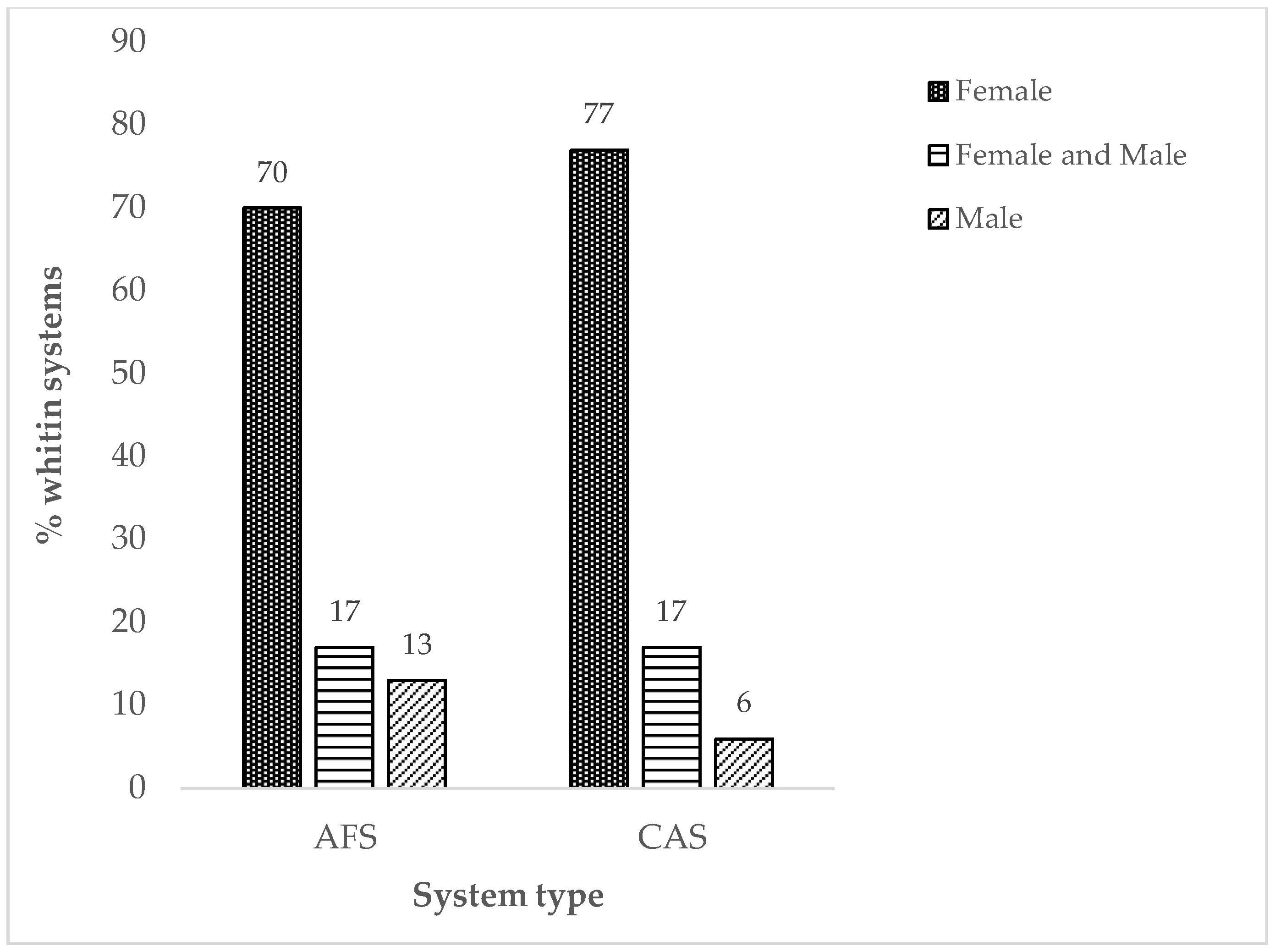
References
- Lowder, S.K.; Skoet, J.; Raney, T. The number, size, and distribution of farms, smallholder farms, and family farms worldwide. World Dev. 2016, 87, 16–29. [Google Scholar] [CrossRef]
- Food and Agriculture Organization of the United Nations. Smallholders and Family Farmers Factsheet. Available online: http://www.fao.org/fileadmin/templates/nr/sustainability_pathways/docs/Factsheet_SMALLHOLDERS.pdf (accessed on 3 November 2016).
- Rapsomanikis, G. The Economic Lives of Smallholder Farmers: An Analysis Based on Household Data from Nine Countries; I5251E/1/12.15; Food and Agriculture Organization of the United Nations (FAO): Rome, Italy, 2015. [Google Scholar]
- Berdegué, J.A.; Fuentealba, R. Latin america: The state of smallholders in agriculture. In New Directions for Smallholder Agriculture; International Fund for Agricultural Development: Rome, Italy, 2011. [Google Scholar]
- Vadjunec, J.; Radel, C.; Turner, B., II. Introduction: The continued importance of smallholders today. Land 2016, 5, 34. [Google Scholar] [CrossRef]
- Soto, B.; Rodriguez, M.; Falconí, C. (Eds.) Políticas Para la Agricultura Familiar en America Latina y el Caribe, 1st ed.; Organización de las Naciones Unidas para la Alimentación y Agricultura—FAO: Santiago, Chile, 2007. [Google Scholar]
- Graeub, B.E.; Chappell, M.J.; Wittman, H.; Ledermann, S.; Kerr, R.B.; Gemmill-Herren, B. The state of family farms in the world. World Dev. 2016, 87, 1–15. [Google Scholar] [CrossRef]
- Costantino, A. Land grabbing in latin america: Another natural resource curse? Agrar. South J. Political Econ. 2014, 3, 17–43. [Google Scholar] [CrossRef]
- Borras, S., Jr.; Franco, J.; Kay, C.; Spoor, M. El acaparamiento de tierras en américa latina y el caribe visto desde una perspectiva internacional más amplia. In Reflexiones Sobre la Concentración y Extranjerización de la Tierra en América Latina y el Caribe; Baquero, F., Gómez, S., Eds.; FAO: Santiago, Chile, 2014; pp. 15–68. [Google Scholar]
- Baquero, F.; Gómez, S. (Eds.) Reflexiones Sobre la Concentración y Extranjerización de la Tierra en América Latina y el Caribe; FAO: Santiago, Chile, 2014. [Google Scholar]
- De Ferranti, D.M. Inequality in Latin America: Breaking with History? The World Bank: Washington, DC, USA, 2004. [Google Scholar]
- Michael, L.; Salcedo, S.; Jara, B.; Boero, V.; Muñoz, M. La agricultura familiar en cifras. In Agricultura Familiar en America Latina y el Caribe: Recomendaciones de Política; Salcedo, S., Guzmán, L., Eds.; FAO: Santiago, Chile, 2014; pp. 35–56. [Google Scholar]
- Altieri, M.A.; Funes-Monzote, F.R.; Petersen, P. Agroecologically efficient agricultural systems for smallholder farmers: Contributions to food sovereignty. Agron. Sustain. Dev. 2012, 32, 1–13. [Google Scholar] [CrossRef]
- Isch, L.E.; Zapatta, A. Tierra y Agua: Interrelaciones de un Acceso Inequitativo; Sistema de Investigación Sobre la Problemática Agraria en el Ecuador: Quito, Ecuador, 2010. [Google Scholar]
- Carrión, D.; Herrera, S. Ecuador Rural del Siglo xxi: Soberanía Alimentaria, Inversión Pública y Política Agraria; Instituto de Estudios Ecuatorianos: Quito, Ecuador, 2012. [Google Scholar]
- Brassel, F.; Herrera, S.; Laforge, M. Reforma Agraria en el Ecuador: Viejos Temas, Nuevos Argumentos; Sistema de Investigación Sobre la Problemática Agraria en el Ecuador: Quito, Ecuador, 2008. [Google Scholar]
- Larrea, C. Tenencia de la tierra, cambios agrarios y etnicidad indígena en el ecuador: 1954–2000. In Desarrollo Rural y Neoliberalismo: Ecuador desde una Perspectiva Comparada; North, L., Cameron, J., Eds.; Universidad Andina Simón Bolívar-Corporación Editora Nacional: Quito, Ecuador, 2008. [Google Scholar]
- INEC. Resultados Nacionales con Resúmenes Provinciales, Censo Nacional Agropecuario 2000. Available online: http://www.ecuadorencifras.gob.ec/censo-nacional-agropecuario/ (accessed on 11 October 2016).
- Barragán, C.; Cahuasquí, L.; Landívar, N.; Ruiz, M. El Derecho a la Alimentación en el Ecuador: Balace del Estado Alimentario de la Población Ecuatoriana desde una Perpectiva de Derechos Humanos; Foodfirst Information and Action Network-FIAN Ecuador: Quito, Ecuador, 2010. [Google Scholar]
- Gaybor, A. Acumulación Capitalista en el Campo y Despojo de Agua; Foro de los Recursos Hídricos: Quito, Ecuador, 2010. [Google Scholar]
- Tamayo, C.; Francisco, H. Dificultades y Desafíos para el Riego Campesino; Todos por el agua, el agua para Todos. Quinto Encuenro Nacional. Documentos de Discusión, Portoviejo and Montecristi—Ecuador, 2008; Isch, E., Ed.; Foro de los Recuros Hídricos-Consorcio CAMAREN: Portoviejo, Ecuador, 2008; pp. 159–173. [Google Scholar]
- Salcedo, S.; Sanchez, A.; Coloma, M. Agricultura familiar y la seguridad alimentaria: El exitoso caso de forsandino. In Agricultura Familiar en America Latina y el Caribe: Recomendaciones de Política; Salcedo, S., Guzmán, L., Eds.; FAO: Santiago, Chile, 2014; pp. 58–78. [Google Scholar]
- Oyarzun, P.J.; Borja, R.M.; Sherwood, S.; Parra, V. Making sense of agrobiodiversity, diet, and intensification of smallholder family farming in the highland andes of ecuador. Ecol. Food Nutr. 2013, 52, 515–541. [Google Scholar] [CrossRef] [PubMed]
- Guerrero, A.; Salvador, S. Panorama Agroeconómico del Ecaudor, una Visión del 2015. Available online: http://sinagap.agricultura.gob.ec/pdf/estudios_agroeconomicos/panorama_agroeconomico_ecuador2015.pdf (accessed on 3 February 2017).
- Altieri, M.A.; Toledo, V.M. The agroecological revolution in latin america: Rescuing nature, ensuring food sovereignty and empowering peasants. J. Peasant Stud. 2011, 38, 587–612. [Google Scholar] [CrossRef]
- Van Noordwijk, M.; Bayala, J.; Hairiah, K.; Lusiana, B.; Muthuri, C.; Khasanah, N.M.; Mulia, R. Agroforestry solutions for buffering climate variability and adapting to change. In Climate Change Impact and Adaptation in Agricultural Systems; Fuhrer, J., Gregory, P.J., Eds.; CAB-International: Wallingford, UK, 2014; pp. 216–232. [Google Scholar]
- Maldonado, P. Mapa del Territorio de la Confederación del Pueblo Kayambi; Confederación del Pueblo Kayambi: Cayambe, Ecuador, 2016. [Google Scholar]
- Pilataxi, C. Plan Estratégico de Desarrollo del Pueblo Kayambi; Confederación del Pueblo Kayambi: Cayambe, Ecuador, 2001. [Google Scholar]
- INEC. Población, Superficie (km2), Densidad Poblacional a Nivel Parroquial. Available online: http://www.ecuadorencifras.gob.ec/informacion-censal-cantonal/ (accessed on 5 October 2016).
- Becker, M. Pueblo Kayambi. Available online: http://www.kayambi.org/index.html (accessed on 10 January 2016).
- Knapp, G. Andean Ecology: Adaptive Dynamics in Ecuador; Westview: Boulder, CO, USA; Oxford, UK, 1991. [Google Scholar]
- Cañadas, L. El Mapa Bioclimático y Ecológico del Ecuador; Banco Central del Ecuador: Quito, Ecuador, 1983. [Google Scholar]
- Medina, G.; Mena, P. Los páramos en el ecuador. In Los Páramos del Ecuador. Particularidades, Problemas y Perspectivas; Medina, G., Mena, P., Hofstede, R., Eds.; Abya Yala: Quito, Ecuador, 2001; pp. 1–23. [Google Scholar]
- Moreno, L. Actualización del Plan de Desarrollo y Ordenemiento Territorial del Gobierno Autónomo Descentralizado Intercultural y Plurinacional Municipal de Cayambe 2015–2025; GADIP Cayambe: Cayambe, Ecuador, 2015. [Google Scholar]
- INAMHI. Mapa de Precipitación Media Multianual (1965–1999). Available online: http://www.serviciometeorologico.gob.ec/wp-content/MapasBiblioteca/5%20PrecipitacionA0.pdf (accessed on 3 January 2017).
- López, M. Generación de geo Información para la Gestión del Territorio a Nivel Nacional, Escala 1: 25,000, Sistemas Productivos Cantón Cayambe; Instituto Espacial Ecuatoriano y Gobierno Autónomo Descentralizado Provincia de Pichincha: Quito, Ecuador, 2013. [Google Scholar]
- INEC. Población por Área, Según Provincia, Cantón y Parroquia de Empadronamiento y Grupos Étnicos. Available online: http://www.ecuadorencifras.gob.ec/informacion-censal-cantonal/ (accessed on 13 January 2017).
- SIISE. Pobreza por Necesidades Básicas Insatisfechas (nbi). Available online: http://www.siise.gob.ec/siiseweb/siiseweb.html?sistema=1# (accessed on 13 February 2017).
- Hofstede, R. El impacto de las actividades humanas sobre el páramo. In Los Páramos del Ecuador. Particularidades, Problemas y Perspectivas; Mena, P., Medina, G., Hofstede, R., Eds.; Abya Yala: Quito, Ecuador, 2001; pp. 161–185. [Google Scholar]
- CODEMIA. Sistematización y Análisis de los Resultados de la Caracterización Agropecuaria y Mapas Temáticos del Sistema de Riego Cayambe—Pedro Moncayo; Consorcio de Desarrollo de Manejo Integral de Agua y Ambiente: Cayambe, Ecuador, 2015. [Google Scholar]
- Zomer, R.J.; Trabucco, A.; Coe, R.; Place, F.; van Noordwijk, N.; Xu, J.C. Trees on Farms: An Update and Reanalysis of Agroforestry’s Global Extent and Socio-ecological Characteristics. Working Paper 179. Available online: http://www.worldagroforestry.org/downloads/Publications/PDFS/WP14064.pdf (accessed on 10 May 2015).
- Hofstede, R.; Lips, J.; Jongsma, W. Geografía, Ecología y Forestación de la Sierra alta del Ecuador; Abya Yala: Quito, Ecuador, 1998. [Google Scholar]
- Spargo, J.; Allen, T.; Kariuki, S. Interpreting Your Soil Test Results. Available online: http://ag.umass.edu/soil-plant-tissue-testing-lab/fact-sheets/interpreting-your-soil-test-results (accessed on 12 June 2016).
- Espinoza, L.; Slaton, N.; Mozaffari, M. Understanding the Numbers on Your Soil Test Report. Available online: https://www.uark.edu/depts/soiltest/NewSoilTest/pdf_files/FSA-2118.pdf (accessed on 13 June 2016).
- Hull, W.X. Manual de Conservación de Suelos; Mexico, D.F., Ed.; Servicio de Lenguas Extranjeras, Secretaría de Estado de los Estados Unidos de América: Whashington, DC, USA, 1992; p. 331. [Google Scholar]
- What Is Sandy Loam. Available online: http://www.southernmulch.com/article-what-is-sandy-loam.php (accessed on 15 June 2017).
- Kavdir, Y.; Zhang, W.; Basso, B.; Smucker, A.J.M. Development of a New Long-term Drought Resilient Soil Water Retention Technology. Available online: http://www.jswconline.org/content/69/5/154A.full.pdf+html?sid=cf76b9ac-4e83-4f03-9da9-841cd72324b0 (accessed on 21 June 2017).
- USDA, Natural Resources Conservation Service. Rangeland Sheet 4, Rangeland Soil Quality-compaction. Available online: https://www.nrcs.usda.gov/Internet/FSE_DOCUMENTS/nrcs142p2_051912.pdf (accessed on 20 June 2017).
- USDA, Natural Resources Conservation Service. Soil Bulk Density/Moisture/Aireation, Soil Quality Kit-guides for Educators. Available online: https://www.nrcs.usda.gov/Internet/FSE_DOCUMENTS/nrcs142p2_053260.pdf (accessed on 22 June 2017).
- Suquilanda, M. Manejo Agroecológico de Suelos, 1st ed.; Ministerio de Agricultura, Ganadería, Acuacultura y Pesca: Quito, Ecuador, 2017; p. 32. [Google Scholar]
- Cornell University. Northeast Region Certified Crop Adviser (NRCCA) Study Resources; Competency Area 2: Soil Hydrology Aem; po 12.1-3 Field Capacity, Permanent Wilting Point & Available Water Capacity. Available online: https://nrcca.cals.cornell.edu/soil/CA2/CA0212.1-3.php (accessed on 23 June 2017).
- Zimmerer, K.S. Overlapping patchworks of mountain agriculture in peru and bolivia: Toward a regional-global landscape model. Hum. Ecol. 1999, 27, 135–165. [Google Scholar] [CrossRef]
- Beniston, M. Climatic change in mountain regions: A review of possible impacts. Clim. Chang. 2003, 59, 5–31. [Google Scholar] [CrossRef]
- Price, M.F. Climate change in mountain regions: A marginal issue? Environmentalist 1995, 15, 272–280. [Google Scholar] [CrossRef]
- De Boef, W.; Haga, M.; Sibanda, L.; Swaminathan, M.; Winters, P. (Eds.) Mainstreaming Agrobiodiversity in Sustainable Food Systems: Scientific Foundations for an Agrobiodiversity Index—Summary; Biodiversity International: Rome, Italy, 2016; p. 30. [Google Scholar]
- Biodiversity and Agriculture: Safeguarding Biodiversity and Securing Food for the World. Available online: https://www.cbd.int/doc/bioday/2008/ibd-2008-booklet-en.pdf (accessed on 29 May 2017).
- Thrupp, L.A. The importance of biodiversity in agroecosystems. J. Crop Improv. 2004, 12, 315–337. [Google Scholar] [CrossRef]
- Leakey, R. Socially modified organisms in multifunctional agriculture—Addressing the needs of smallholder farmers in africa. Arch. Crop Sci. 2017, 1, 20–29. [Google Scholar]
- Pascual, U.; Narloch, U.; Nordhagen, S.; Drucker, A. The economics of agrobiodiversity conservation for food security under climate change. Economia Agraria y Recursos Naturales 2011, 11, 191–220. [Google Scholar] [CrossRef]
- Zimmerer, K.; Vanek, S. Toward the integrated framework analysis of linkages among agrobiodiversity, livelihood diversification, ecological systems, and sustainability amid global change. Land 2016, 5, 10. [Google Scholar] [CrossRef]
- Sconnes, I. Sustainable Rural Livelihoods: A Framework for Analysis. Available online: https://opendocs.ids.ac.uk/opendocs/bitstream/handle/123456789/3390/Wp72.pdf?sequence=1 (accessed on 6 December 2017).
- Chambers, R.; Conway, G. Sustainable Rural Livelihoods: Practical Concepts for the 21st Century. Available online: https://opendocs.ids.ac.uk/opendocs/bitstream/handle/123456789/775/Dp296.pdf?sequence=1 (accessed on 28 November 2017).
- Chiriboga, M. La pobreza rural y la producción agropecuaria. In Ecuador: El mito del Desarrollo; Editorial El Conejo: Quito, Ecuador, 1982. [Google Scholar]
- Wong, S.; Ludeña, C. Caracterización de la Agricultura Familiar en Ecuador. Preliminary Report 1. Proyecto gcp/rla/152/iab; FAO: Quito, Ecuador, 2006. [Google Scholar]
- Hussein, K.; Nelson, J. Sustainable Livelihoods and Livelihood Diversification. Available online: http://www.ids.ac.uk/files/Wp69.pdf (accessed on 19 December 2017).
- Ellis, F. The determinants of rural livelihood diversification in developing countries. J. Agric. Econ. 2000, 51, 289–302. [Google Scholar] [CrossRef]
- Ampudia, L. (Ed.) Impacto de la Floricultura en los Campesinos de Cayambe; Instituto de Ecología y Desarrollo de las Comunidades Andinas (IEDECA): Cayambe, Ecuador, 1999; p. 108. [Google Scholar]
- Ávalos, D. Dinámicas de Agricultura Familiar en Torno a la Existencia de la Producción Florícola en la Parroquia Tabacundo, Ecuador; Facultad Latinomaericana de Ciencias Sociales, FLACSO Ecuador: Quito, Ecuador, 2017. [Google Scholar]
- Newman, C.; Larreamendy, P.; Maldonado, A. Mujeres y Floricultura, Cambios y Consecuencias en el Hogar; Abya-Yala, World Bank and CONAMU: Quito, Ecuador, 2002; p. 86. [Google Scholar]
- Vega, H.; Philhower, E. 2009 Ecuador Fresh Flower Industry Situation. Available online: https://gain.fas.usda.gov/Recent%20GAIN%20Publications/2009%20Ecuador%20Fresh%20Flower%20Industry%20Situation_Quito_Ecuador_6-9-2009.pdf (accessed on 12 January 2018).
- Conefrey, M. Roses with Altitude: Why Ecuador’s Flower Industry Stands Out. Available online: https://www.ft.com/content/eb5114d6-d846-11e4-ba53-00144feab7de (accessed on 12 January 2018).
- Martínez, L. La Agricultura Familiar en el Ecuador. Available online: http://portalsiget.net/ArchivosSIGET/recursos/Archivos/1682015_AgriculturaFamiliarE.pdf (accessed on 22 December 2017).
- Feder, G. Land ownership security and farm productivity: Evidence from thailand. J. Dev. Stud. 1987, 24, 16–30. [Google Scholar] [CrossRef]
- FAO. Land Tenure and Rural Development. Available online: ftp://ftp.fao.org/docrep/fao/005/y4307E/y4307E00.pdf (accessed on 26 August 2017).
- Lasco, R.D.; Delfino, R.J.P.; Espaldon, M.L.O. Agroforestry systems: Helping smallholders adapt to climate risks while mitigating climate change. Wiley Interdiscip. Rev. Clim. Chang. 2014, 5, 825–833. [Google Scholar] [CrossRef]
- Selvarajh-Jaffery, R.; Obanyi, G.; Wagner, B.; Sulzberger, E. (Eds.) Tackling Global Challenges through Agroforestry. Annual Report 2006; World Agroforestry Centre (ICRAF): Nairobi, Kenya, 2007; p. 60. [Google Scholar]
- Watson, R.T.; Noble, I.R.; Bolin, B.; Ravindranath, N.H.; Verardo, D.J.; Dokken, D.J. (Eds.) Land Use, Land-Use Change and Forestry. Special Reports; IPCC: Cambridge, UK, 2000; p. 375. [Google Scholar]
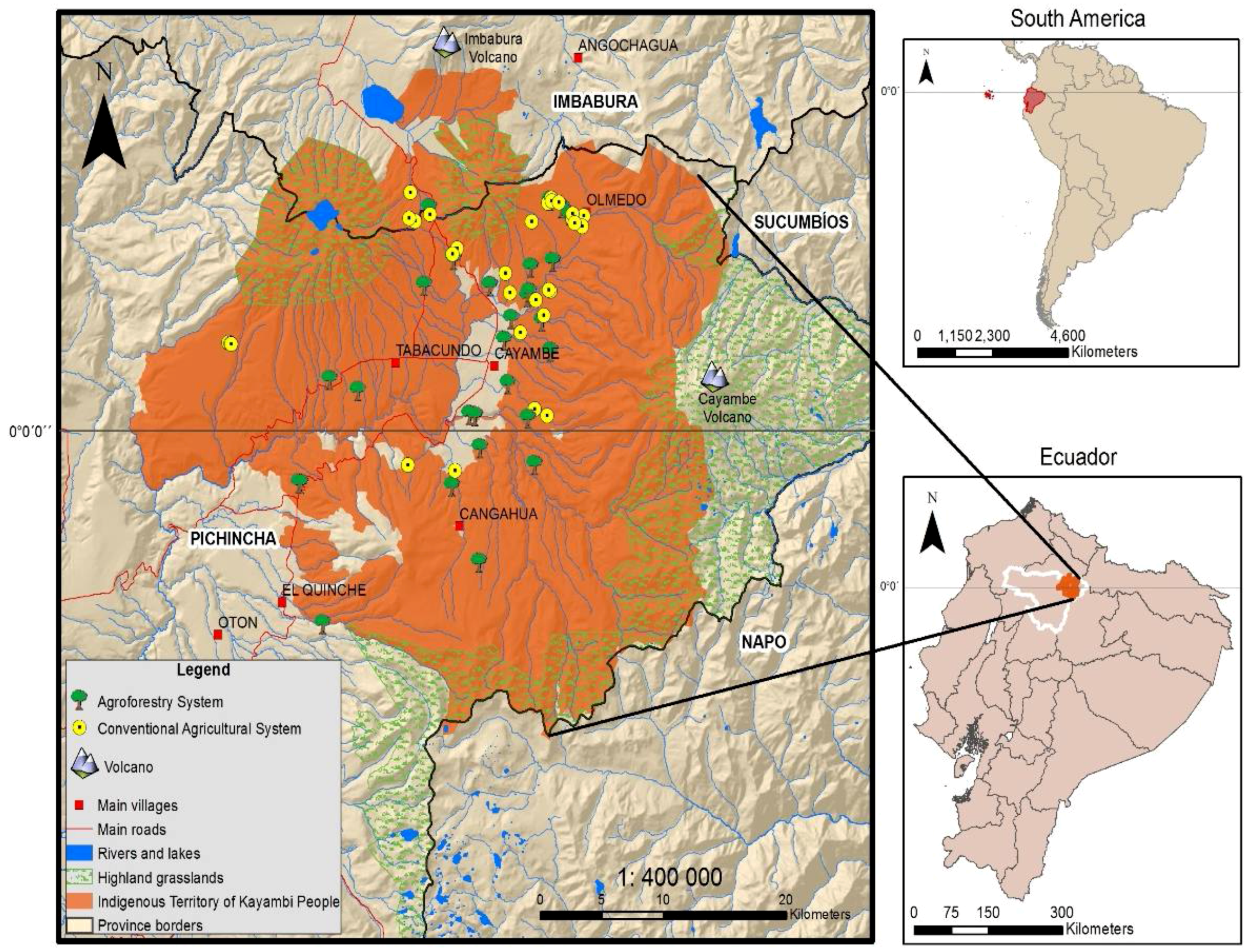
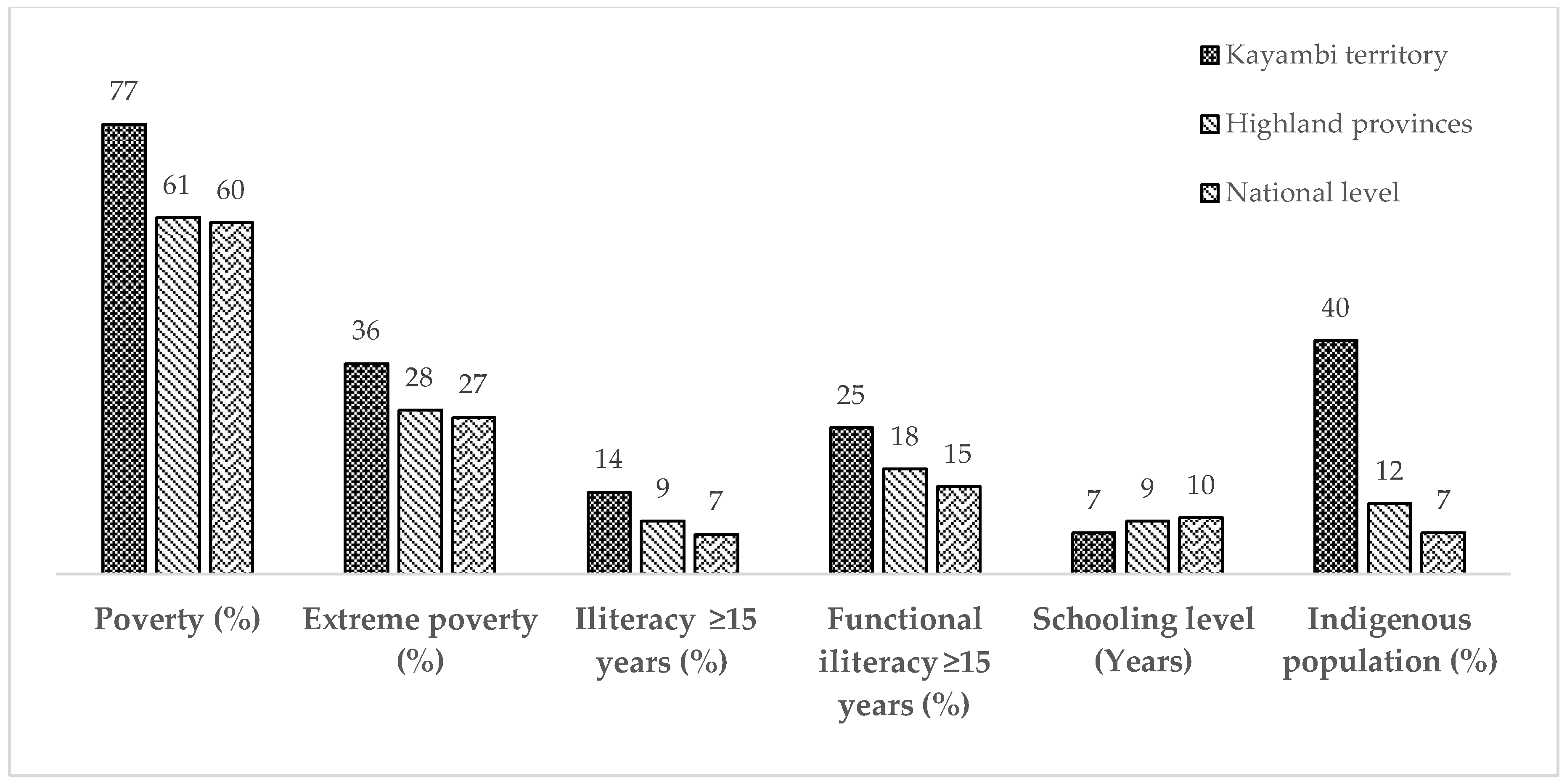
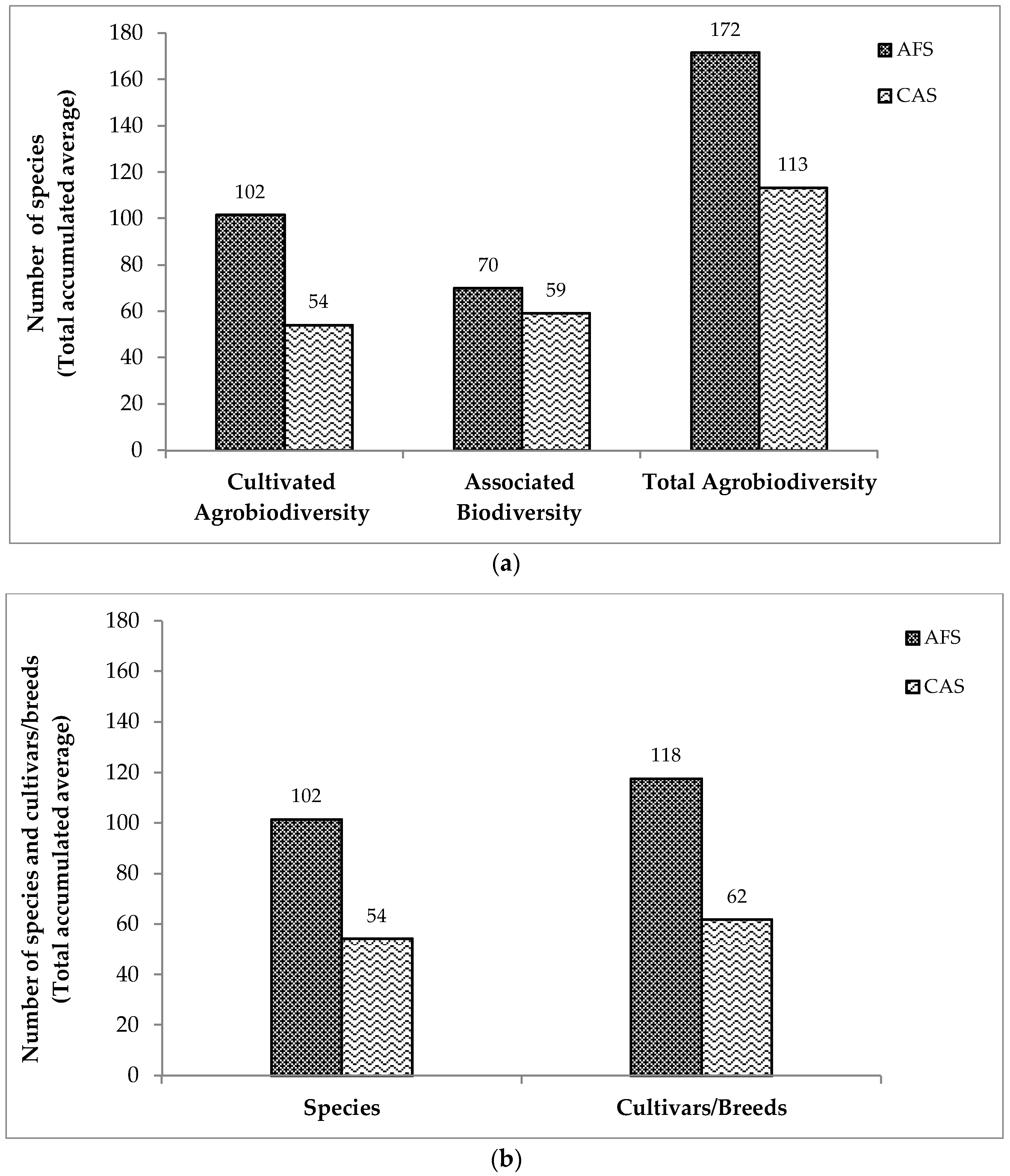

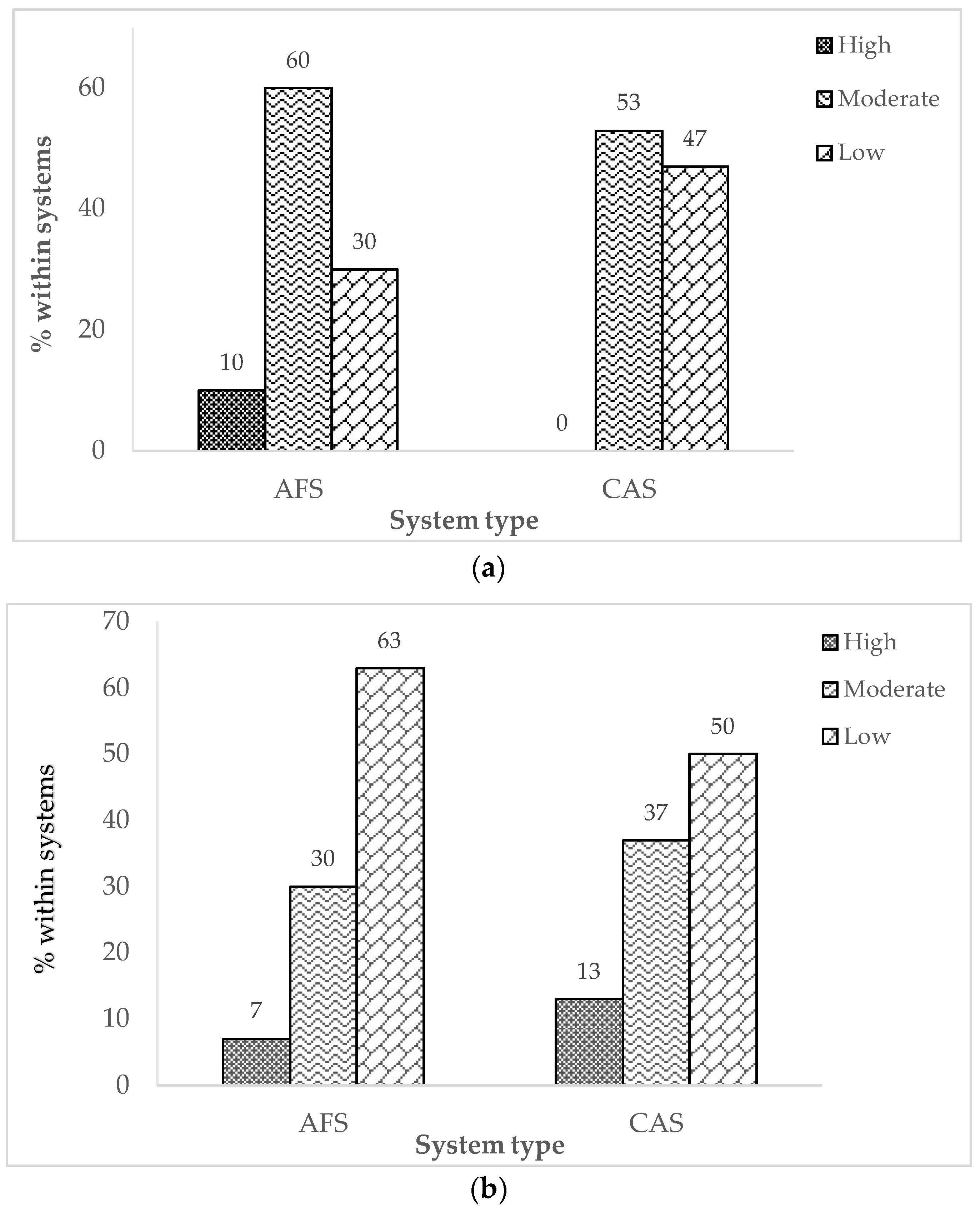
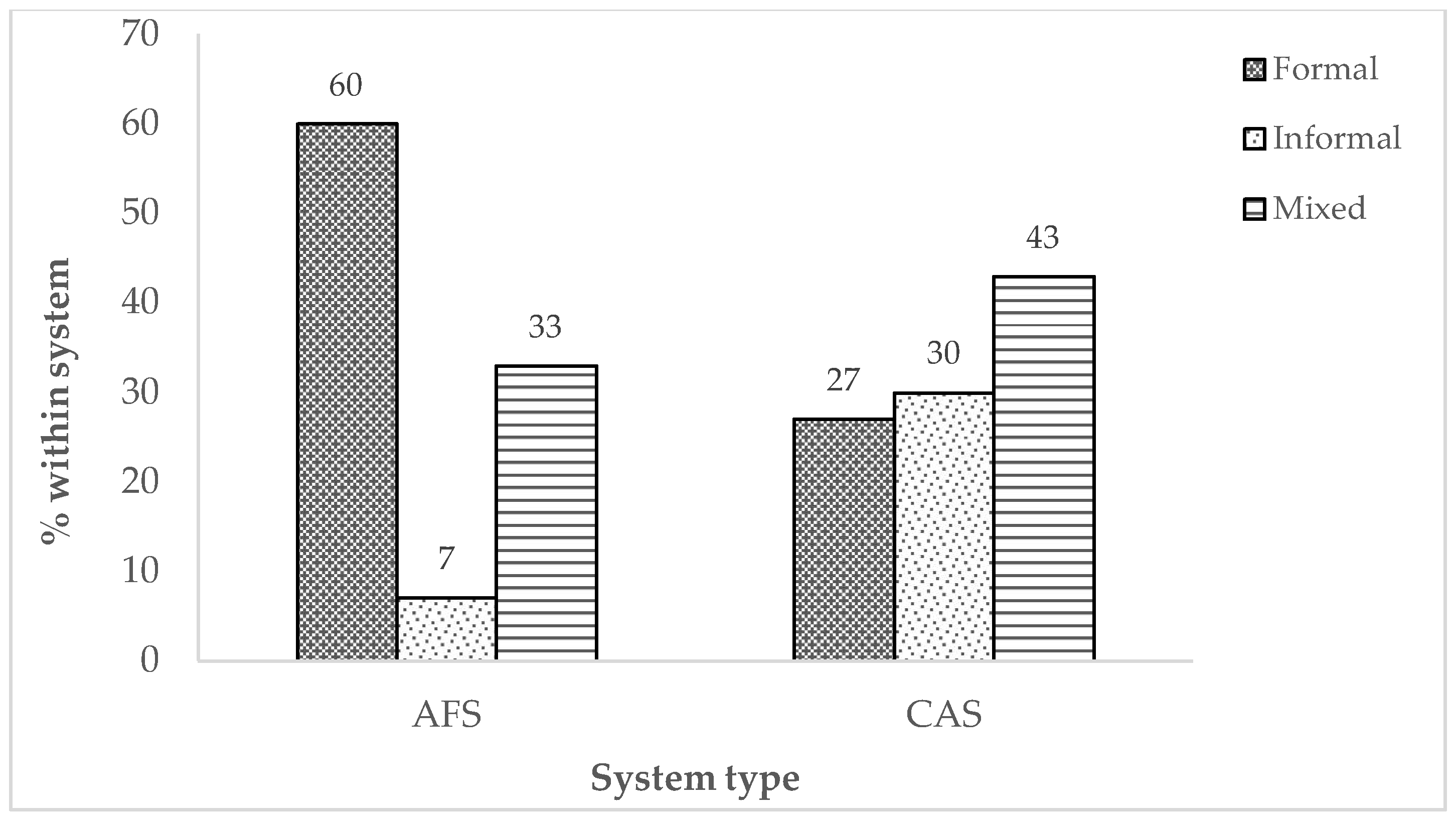

| Agrobiodiversity | Number of spp. | % of Difference ª | Number of Cultivars/Breeds | % of Difference ª | ||||
|---|---|---|---|---|---|---|---|---|
| AFSº | CASº | AFSº | CASº | |||||
| Cultivated Biodiversity (Subtotal 1) | ||||||||
| Trees and shrubs | 32 | 13 | 44 | **** | 33 | 13 | 44 | **** |
| Legumes and grains | 9 | 8 | 11 | *** | 21 | 13 | 24 | *** |
| Tubers and roots | 5 | 4 | 12 | ** | 11 | 7 | 19 | ** |
| Non-tree and shrub fruits | 3 | 2 | 25 | **** | 3 | 2 | 26 | **** |
| Vegetables | 21 | 11 | 31 | **** | 25 | 12 | 34 | **** |
| Pastures | 8 | 6 | 12 | ** | 8 | 6 | 12 | ** |
| Medicinal, aromatic and condiment plants | 11 | 4 | 44 | **** | 11 | 4 | 45 | **** |
| Livestock † | 1 | 1 | 3 | 1 | 1 | 3 | ||
| Minor animals ‡ | 4 | 3 | 22 | **** | 4 | 3 | 23 | **** |
| Other (burden animals, ornamental and cultural spp.) | 7 | 3 | 39 | *** | - | - | - | |
| Subtotal 1 | 102 | 54 | 30 | **** | 118 | 62 | 31 | **** |
| Associated Biodiversity (Subtotal 2) | ||||||||
| Wild animals: | ||||||||
| Birds | 13 | 11 | 8 | ** | - | - | - | |
| Reptiles | 2 | 2 | 6 | - | - | - | ||
| Amphibians | 2 | 2 | 14 | ** | - | - | - | |
| Mammals | 5 | 4 | 8 | ** | - | - | - | |
| Invertebrates | 30 | 27 | 5 | - | - | - | ||
| Wild animals (Subtotal 2.1) | 52 | 46 | 6 | ** | - | - | - | |
| Wild plants (Subtotal 2.2) | 18 | 13 | 15 | **** | - | - | - | |
| Subtotal 2 (Subtotal 2.1 + Subtotal 2.2) | 70 | 59 | 8 | *** | - | - | - | |
| Total (Subtotal 1 + Subtotal 2) | 172 | 113 | 20 | **** | 118 | 62 | 31 | **** |
| Agrobiodiversity | Number of Subsistence/Functional spp. | % of Difference ª | Number of Commercial spp. | % of Difference ª | ||||
|---|---|---|---|---|---|---|---|---|
| AFSº | CASº | AFSº | CASº | |||||
| Cultivated biodiversity (Subtotal 1) | ||||||||
| Trees and shrubs | 31 | 12 | 43 | **** | 1 | 0 | 89 | * |
| Legumes and grains | 7 | 7 | 1 | 2 | 1 | 41 | ** | |
| Tubers and roots | 4 | 3 | 9 | 1 | 0 | 40 | * | |
| Non-tree and shrub fruits | 3 | 2 | 23 | *** | 0 | 0 | 52 | ** |
| Vegetables | 12 | 9 | 16 | ** | 8 | 2 | 59 | **** |
| Pastures | 8 | 6 | 10 | ** | 0 | 0 | 100 | |
| Medicinal, aromatic and condiment plants | 8 | 4 | 34 | **** | 3 | 0 | 91 | ** |
| Livestock † | 1 | 0 | 15 | 1 | 1 | 7 | ||
| Minor animals ‡ | 3 | 2 | 18 | *** | 1 | 0 | 38 | ** |
| Other (burden animals, ornamental & cultural spp.) | 7 | 3 | 39 | *** | 0 | 0 | 100 | |
| Subtotal 1 | 84 | 49 | 26 | **** | 17 | 5 | 56 | **** |
| Associated biodiversity (Subtotal 2) | ||||||||
| Wild animals: | ||||||||
| Birds | 13 | 11 | 8 | ** | 0 | 0 | 0 | |
| Reptiles | 2 | 2 | 6 | 0 | 0 | 0 | ||
| Amphibians | 2 | 2 | 14 | ** | 0 | 0 | 0 | |
| Mammals | 5 | 4 | 8 | ** | 0 | 0 | 0 | |
| Invertebrates | 30 | 27 | 5 | 0 | 0 | 100 | ||
| Wild animals (Subtotal 2.1) | 52 | 46 | 6 | ** | 0 | 0 | 100 | |
| Wild plants (Subtotal 2.2) | 18 | 13 | 15 | **** | 0 | 0 | 100 | |
| Subtotal 2 (Subtotal 2.1 + Subtotal 2.2) | 70 | 59 | 8 | *** | 0 | 0 | 100 | |
| Total (Subtotal 1 + Subtotal 2) | 154 | 108 | 17 | **** | 17 | 5 | 56 | **** |
© 2018 by the authors. Licensee MDPI, Basel, Switzerland. This article is an open access article distributed under the terms and conditions of the Creative Commons Attribution (CC BY) license (http://creativecommons.org/licenses/by/4.0/).
Share and Cite
Córdova, R.; Hogarth, N.J.; Kanninen, M. Sustainability of Smallholder Livelihoods in the Ecuadorian Highlands: A Comparison of Agroforestry and Conventional Agriculture Systems in the Indigenous Territory of Kayambi People. Land 2018, 7, 45. https://doi.org/10.3390/land7020045
Córdova R, Hogarth NJ, Kanninen M. Sustainability of Smallholder Livelihoods in the Ecuadorian Highlands: A Comparison of Agroforestry and Conventional Agriculture Systems in the Indigenous Territory of Kayambi People. Land. 2018; 7(2):45. https://doi.org/10.3390/land7020045
Chicago/Turabian StyleCórdova, Raúl, Nicholas J. Hogarth, and Markku Kanninen. 2018. "Sustainability of Smallholder Livelihoods in the Ecuadorian Highlands: A Comparison of Agroforestry and Conventional Agriculture Systems in the Indigenous Territory of Kayambi People" Land 7, no. 2: 45. https://doi.org/10.3390/land7020045
APA StyleCórdova, R., Hogarth, N. J., & Kanninen, M. (2018). Sustainability of Smallholder Livelihoods in the Ecuadorian Highlands: A Comparison of Agroforestry and Conventional Agriculture Systems in the Indigenous Territory of Kayambi People. Land, 7(2), 45. https://doi.org/10.3390/land7020045





